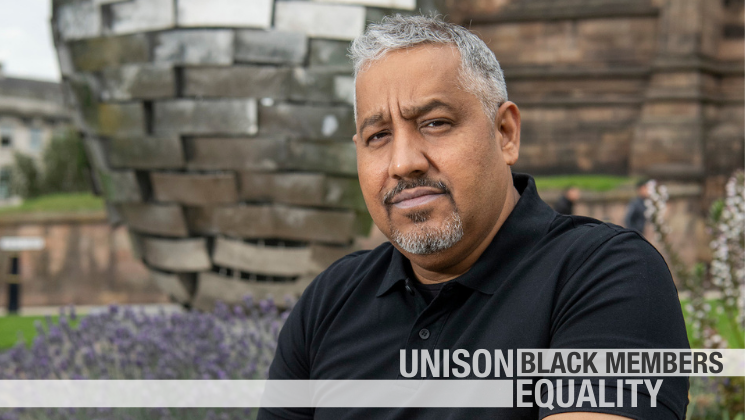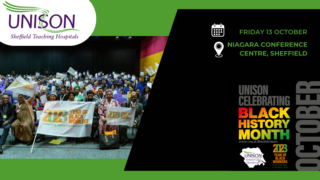The Black Lives Matter movement has rightly focused attention on racism in all its forms. Here feature writer for UNISON Active, Ruth McGuire, assesses the barriers to promotion faced by black people in the region.
You’ve heard of the “Glass Ceiling”, well allow me to introduce you to the “Snowy Peaks”. Basically it means the higher up you go in public sector organisations, the whiter the staff.
The topographical analogy works when you apply it to the presence of black and minority ethnic (BAME) people in senior leadership roles, but it also applies to the challenges faced by BAME staff in climbing their way to the top.
The vivid phrase comes from a 2014 report by Roger Kline “Snowy white peaks of the NHS: a survey of discrimination in governance and leadership and the potential impact on patient care in London and England.”
Fast forward to today and Yorkshire & Humberside where the discrimination clearly continues – the higher the NHS pay band, the lower the proportion of BAME staff. Across the region, the percentage of BAME people appointed to executive level posts in trusts, ranges from zero in the vast majority of cases to 22 per cent in one trust (Workforce Race Equality Standard 2020 data).
The picture is similarly bleak at local authorities. A 2018 “Local Government Leadership” report carried out by recruitment agency Green Park didn’t mince its words. “The proportion of BAME representation in local government leadership positions is woeful.”
Precise figures for all the employers covered by UNISON in the region are not available. But Abdul Rashid, chair of UNISON’s regional black members’ group, suggests that the representation of BAME staff in senior roles at local authorities remains as Green Park describes: woeful.
This is confirmed by a report for Leeds City Council, “Equality Improvement Priorities Summary 2018 – 2022 Tackling poverty and reducing inequalities. Update November 2020”. It makes clear that “increasing the representation of employees with protected characteristics at leadership and management levels” in the local authority is an area in need of substantial improvement. Though BAME people comprise at least 19% of the city’s population, this proportion falls to 7.81% at the most senior council grades. This was a slight percentage decrease on the previous year due to an overall increase in senior staff numbers.
The report points out that, “our current workforce profile demonstrates that we are not representative of the city (compared to 2011 census data), and the five year trend since 2011 shows that there has not been much real change or improvement in our workforce diversity.”
Meanwhile in Sheffield, the second largest city in the region, its “Council Workforce Employee Report 1st April 2019 to 31st March 2020” confirmed that BAME staff are underrepresented in the most senior roles. With a BAME population of 19% in 2011, the percentage of BAME chief officers has decreased slightly on previous years to 7.4%.
As both cities’ demographic profiles are likely to have diversified further since census data collected in 2011, the disparities are probably greater than such reports can currently show.
BARRIER
John Campbell, deputy regional convenor, suggests that “unconscious bias and white privilege” are two of the reasons for the poor representation of BAME staff in leadership roles.
He says: “I know of nurses within a South Yorkshire hospital who were often asked to mentor and support others such as matrons and directors in their new roles. These nurses were considered good enough to be mentors, but not good enough for promotion. I also know a black man who has three degrees including a Masters but he’s only a clerical officer. He’s constantly applying for promotions but never gets the job.”
He adds: ‘‘You’ll see lots of black faces around the place, but you won’t see them as managers.” Similarly, Abdul who works with members from local authorities, education and other local public services, believes that indirect discrimination is also a barrier to the progression of BAME staff. “Equality policies are in place but not always the practice,” he says. “You see the indirect discrimination in the lack of opportunities and lack of promotion of BAME staff. Members also feel that they have to be twice as good as a white person to get promotions. For black women, the situation is even worse, they are even less likely to get into senior positions.”
In theory the Equality Act should protect members from racial discrimination. However, enforcing the law is another mountain that BAME members have to climb. Abdul says that only about thirty percent of cases he and his colleagues deal with are sent onto Thompsons Solicitors. “Often, this is because members have left it too late to submit a claim and by the time they decide to act, they have already passed the three-month deadline.”
In addition to racial discrimination, some black members face outright racist abuse at work. John Campbell said: “I know some nursing staff who’ve been called the ‘N’ word but when they reported the abuse, managers were reluctant to call in the police.
“It was only when UNISON intervened that action was taken. I also know of international nurses who faced horrendous abuse and were even spat on. Incidents were reported to managers, but nothing was done.” In other cases, while explicitly racist language has not been used to abuse staff, derogatory language has been.
A case in point is that of IT engineer Sandy Sheun who brought a successful claim against his employers, Northern General Hospital (Sheffield Teaching Hospitals NHS Trust) for racial harassment.
His complaint was successfully upheld by an employment tribunal in January 2020 and widely reported in the media. The tribunal upheld Sandy’s complaint and found that his dignity was ‘undermined’ by the behaviour of colleagues who regularly mimicked the Chinese accent and made ‘Kung Fu’ noises.
A further barrier faced by black members is the disproportionate risk they face of being disciplined or being subjected to capability proceedings. National NHS statistics show that BAME staff are more likely to face disciplinary action than their white colleagues. From his work with members in other sectors, Abdul agrees. He says: “Black members tend to get pulled up on capability issues, but white members get training, development and support to improve.”
Fine sounding policies and often superficial equality training courses are not enough to ensure that black members are treated fairly and equally. “Activism” is needed by both employers and UNISON. Employers need to actively review and revise their recruitment practices to root out the unconscious bias which leaves recruiters appointing people that look like themselves.
“Organisations need to look at recruitment panels to make sure that there is someone on the panel who understands equality and diversity issues,” Abdul suggests. “More needs to be done at the recruitment stage but also to support BAME members when they are appointed to senior roles because they will face double the issues faced by their white colleagues.”
Positive action is also needed to encourage and support BAME members to apply for more senior roles and to ensure they have equal access to the training and opportunities that will equip them to take on leadership roles. John says: “Staff need to be encouraged to take on supervisory roles and the boardroom has to lead on this. NHS England also has to take the lead.”
There is also a role for UNISON in leading by example. BAME members in senior roles within the union are few and far between and according to one official, applications to senior roles from BAME members are “disappointing”. So, can UNISON do more to ensure black members are well represented in senior roles? Are senior roles advertised widely and in ethnic media for example? And given that discrimination is not going away anytime soon, UNISON needs to do more to ensure members and union reps are competent and confident to take legal action to “stand up to racism”, racial harassment and discrimination.
ABHORRENT
Convenor for the West Yorkshire Combined Authority Pam Sian points out that events that have taken place across the world since the murder of George Floyd have not only drawn attention to the abhorrent police brutality that led to Mr Floyd’s death. “The Black Lives Matters movement has also rightly focused attention on systematic and structural racism more widely in our society. It has given us all cause to question whether we are doing enough to create change and reduce racial inequality.”
If you want to find out more about UNISON’s ongoing work to challenge racism and inequality in the workplace, please visit the Black members section of our website for more information.
This article was originally printed in the Winter 2020 edition of UNISON ACTIVE!, the magazine for members in the Yorkshire & Humberside Region. References to representation across the region have been amended to reflect 2021 data.






